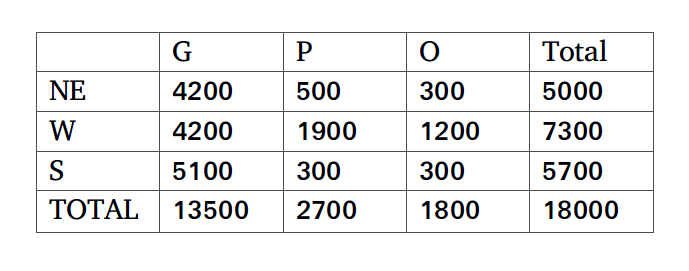A study to look at the early learning of rural kids was carried out in a number of villages spanning three states, chosen from the North East (NE), the West (W) and the South (S). 50 four-year old kids each were sampled from each of the 150 villages from NE, 250 villages from W and 200 villages from S. It was found that of the 30000 surveyed kids 55% studied in primary schools run by government (G), 37% in private schools (P) while the remaining 8% did not go to school (O).
The kids surveyed were further divided into two groups based on whether their mothers dropped out of school before completing primary education or not.. The table below gives the number of kids in different types of schools for mothers who dropped out of school before completing primary education:

It is also known that:
1. In S, 60% of the surveyed kids were in G. Moreover, In S, all surveyed kids whose mothers had completed primary education were in school.
2. In NE, among the O kids, 50% had mothers who had dropped out before completing primary education.
3. The number of kids in G in NE was the same as the number of kids in G in W.
Let us make note of the information given in the set.
The set states that rural kids were surveyed from 3 regions NE, West and South.
50 students each were surveyed from 150 villages in the NE, 250 villages from the West and 200 villages from the South.
Total number of kids from the NE = 150*50 = 7500
Total number of kids from the West = 250*50 = 12500
Total number of kids from the South = 200*50 = 10,000.
The table, given in the question, gives the number of students whose mothers dropped out before completing primary education. Therefore, the mothers of the remaining students should have completed primary education.
There are 7500 students from the NE in total. The mothers of 5000 of those students dropped out before completing primary education. Therefore, the remaining 2500 kids should have mothers who have completed primary education.
Let us make 2 tables - one representing the number of students and the other representing the number of students whose mother has completed primary education.
55% of the surveyed kids studied in schools run by the Government.
Number of kids studying in Govt. School should be 0.55*30000 = 16,500
From the given table, we know that the mothers of 13,500 kids who went to Govt. Schools dropped out of primary school.
Therefore, the remaining 16,500 - 13,500 = 3000 kids should have mother who have completed primary school.
37% of the surveyed kids study in private schools.
Number of kids studying in private schools should be 0.37*30000 = 11,100.
Number of kids in private schools whose mothers have completed primary school = 11,100 - 2700 = 8400.
8% of the surveyed kids did not go to school.
Number of kids who did not go to school = 0.08* 30000 = 2400
Number of kids not going to schools whose mothers have completed primary school = 2400 - 1800 = 600.
In S, 60% of the surveyed kids were in G.
Therefore, 6000 kids in S must be from G.
In NE, among the O kids, 50% had mothers who had dropped out before completing primary education.
There are 300 O kids whose mothers dropped out before completing primary education. These kids represent 50% of the total number of O-kids. Therefore, there must be 600 O-kids from NE - 300 kids should have mothers who dropped out before completing primary education and 300 kids should have mothers who have completed primary education.
The number of kids in G in NE was the same as the number of kids in G in W. Therefore, the number of kids in G in NE and the number of kids in G in W should be equal to 5250. Total number of kids:

Number of kids whose mothers have completed primary education:

We have been given that in S, all surveyed kids whose mothers had completed primary education were in school. Therefore, the number of kids not going to school whose mothers have completed primary education in S should be 0. Filling the tables, we get,
Total number of kids:

Number of kids whose mothers have completed primary education:

As we can see from the table, 3700 kids out of the 10,000 kids from S are studying in P. 37% of the total number of students from S were studying in P. Therefore, option A is the right answer.
Video Solution

Create a FREE account and get:
- All Quant CAT complete Formulas and shortcuts PDF
- 38+ CAT previous year papers with video solutions PDF
- 5000+ Topic-wise Previous year CAT Solved Questions for Free



